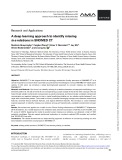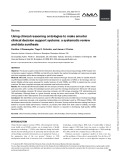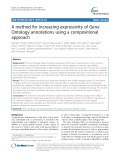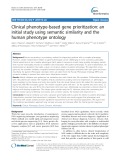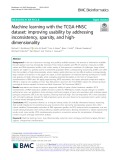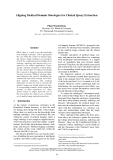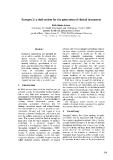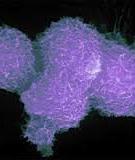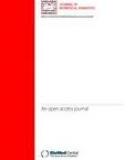
Clinical ontology
-
The College of American Pathologists (CAP) introduced the first cancer synoptic reporting protocols in 1998. However, the objective of a fully computable and machine-readable cancer synoptic report remains elusive due to insufficient definitional content in Systematized Nomenclature of Medicine – Clinical Terms (SNOMED CT) and Logical Observation Identifiers Names and Codes (LOINC).
 8p
8p  visteverogers
visteverogers
 24-06-2023
24-06-2023
 3
3
 2
2
 Download
Download
-
Concept normalization, the task of linking phrases in text to concepts in an ontology, is useful for many downstream tasks including relation extraction, information retrieval, etc. We present a generate-andrank concept normalization system based on our participation in the 2019 National NLP Clinical Challenges Shared Task Track 3 Concept Normalization.
 10p
10p  vighostrider
vighostrider
 25-05-2023
25-05-2023
 4
4
 2
2
 Download
Download
-
SNOMED CT is the largest clinical terminology worldwide. Quality assurance of SNOMED CT is of utmost importance to ensure that it provides accurate domain knowledge to various SNOMED CT-based applications. In this work, we introduce a deep learning-based approach to uncover missing is-a relations in SNOMED CT.
 10p
10p  vighostrider
vighostrider
 25-05-2023
25-05-2023
 3
3
 2
2
 Download
Download
-
The study sought to describe the literature describing clinical reasoning ontology (CRO)–based clinical decision support systems (CDSSs) and identify and classify the medical knowledge and reasoning concepts and their properties within these ontologies to guide future research.
 16p
16p  vighostrider
vighostrider
 25-05-2023
25-05-2023
 2
2
 2
2
 Download
Download
-
The Gene Ontology project integrates data about the function of gene products across a diverse range of organisms, allowing the transfer of knowledge from model organisms to humans, and enabling computational analyses for interpretation of high-throughput experimental and clinical data.
 11p
11p  vikentucky2711
vikentucky2711
 26-11-2020
26-11-2020
 11
11
 1
1
 Download
Download
-
Exome sequencing is a promising method for diagnosing patients with a complex phenotype. However, variant interpretation relative to patient phenotype can be challenging in some scenarios, particularly clinical assessment of rare complex phenotypes.
 11p
11p  vikentucky2711
vikentucky2711
 26-11-2020
26-11-2020
 7
7
 0
0
 Download
Download
-
Despite a wide adoption of English in science, a significant amount of biomedical data are produced in other languages, such as French. Yet a majority of natural language processing or semantic tools as well as domain terminologies or ontologies are only available in English, and cannot be readily applied to other languages, due to fundamental linguistic differences.
 26p
26p  viconnecticut2711
viconnecticut2711
 28-10-2020
28-10-2020
 11
11
 1
1
 Download
Download
-
In the era of precision oncology and publicly available datasets, the amount of information available for each patient case has dramatically increased. From clinical variables and PET-CT radiomics measures to DNAvariant and RNA expression profiles, such a wide variety of data presents a multitude of challenges.
 9p
9p  vijisoo2711
vijisoo2711
 27-10-2020
27-10-2020
 15
15
 1
1
 Download
Download
-
Often, there is a need to use the knowledge from multiple ontologies. This is particularly the case within the context of medical imaging, where a single ontology is not enough to provide the complementary knowledge about anatomy, radiology and diseases that is required by the related applications. Consequently, semantic integration of these different but related types of medical knowledge that is present in disparate domain ontologies becomes necessary. Medical ontology alignment addresses this need by identifying the semantically equivalent concepts across multiple medical ontologies. ...
 9p
9p  bunthai_1
bunthai_1
 06-05-2013
06-05-2013
 63
63
 6
6
 Download
Download
-
Suregen-2 applications are intended for use as add-on modules for clinical information systems. Currently, Suregen-2 permits refinement of the predefined medical ontology, specification of text plans and description knowledge for objects of the ontology. It has built-in constructs for referential expressions, aggregation, enumeration and recurrent semantic constellations. A first application built with Suregen-2, which currently supports German only, is in routine use.
 4p
4p  bunthai_1
bunthai_1
 06-05-2013
06-05-2013
 50
50
 4
4
 Download
Download
-
This paper presents a hybrid approach to question answering in the clinical domain that combines techniques from summarization and information retrieval. We tackle a frequently-occurring class of questions that takes the form “What is the best drug treatment for X?” Starting from an initial set of MEDLINE citations, our system first identifies the drugs under study. Abstracts are then clustered using semantic classes from the UMLS ontology. Finally, a short extractive summary is generated for each abstract to populate the clusters. ...
 8p
8p  hongvang_1
hongvang_1
 16-04-2013
16-04-2013
 49
49
 1
1
 Download
Download
-
One of the most important steps in transforming the Thésaurus into an ontology is to represent the concepts and their connections in a machine processable way. In our ontology, each concept is given a formal designator and the relationships between them are formalized in the base ontology language. This overcomes any ambiguity between natural language based descriptive text, and formal concept names. In the NCI Thésaurus, names of entities are semantically rich. Some...
 24p
24p  taisaokhongthedung
taisaokhongthedung
 09-01-2013
09-01-2013
 52
52
 1
1
 Download
Download
-
This article was written as a result of the authors teaching a network security subject in the Faculty of IT, at the University of Technology Sydney. There are many concepts which need to be well understood by network security students and practitioners. To assist in this there have been several attempts to classify different aspects of the subject area.
 10p
10p  khongmuonnghe
khongmuonnghe
 04-01-2013
04-01-2013
 51
51
 5
5
 Download
Download
-
The scope of the Translational Medicine Ontology (TMO) is defined by the use case terminology and respective data sources. Each term and corresponding data source was analyzed for its conceptual, representational and reasoning capability as required by the use case requirements. TMO terms were obtained from a lexical analysis of sample research questions from 14 types of users, all of whom were involved in aspects of research, clinical care and or business (Table 2). Terms were formalized as referring to classes, relations or individuals in the OWL ontology.
 18p
18p  thangbienthai
thangbienthai
 17-11-2012
17-11-2012
 73
73
 2
2
 Download
Download
-
In this paper, participants in the Translational Medicine task force of the World Wide Web Consortium’s Health Care and Life Sciences Interest Group (W3C HCLSIG) present the Translational Medicine Ontology (TMO) and the Translational Medicine Knowledge Base (TMKB). The TMKB consists of the TMO, mappings to other terminologies and ontologies, and data in RDF format spanning discovery research and drug development, which are of therapeutic relevance to clinical research and clinical practice.
 21p
21p  thangbienthai
thangbienthai
 17-11-2012
17-11-2012
 67
67
 3
3
 Download
Download
CHỦ ĐỀ BẠN MUỐN TÌM










